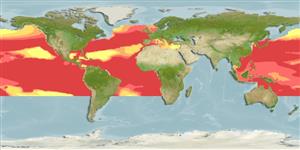Environment: milieu / climate zone / depth range / distribution range
Ekologi
laut; oceanodromus (Ref. 51243); kisaran kedalaman 0 - 200 m (Ref. 6517). Subtropical; 60°N - 25°S, 180°W - 180°E
Atlantic, Indian and Pacific: in temperate and tropical waters (Ref. 47377). Western Atlantic: USA and eastern Gulf of Mexico (Ref. 7251). Eastern Atlantic: Bergen, Norway to Madeira and near the Azores, including western Mediterranean; west of Cape Point, South Africa (Ref. 6657). Western Pacific: Japan, Australia, and New Zealand (Ref. 5755). Eastern Pacific: Oregon, USA to Chile (Ref. 2850).
Size / Weight / umur
Maturity: Lm ? range ? - ? cm
Max length : 200 cm TL jantan/; (Ref. 9314); common length : 152 cm SL jantan/; (Ref. 6517); Berat maksimum terpublikasi: 150.0 kg (Ref. 47377)
duri punggung lunak (Keseluruhan (total)): 20; Duri dubur 0; Sirip dubur lunak: 18; vertebrata, bertulang belakang: 22. Absence of dorsal and anal spines and of pelvic fins contribute to streamlining of the body, as does the flat and relatively consolidated opercular spines (Ref. 11017, p. 74).
Oceanic and epipelagic; found near surface or in deep water (Ref. 10821). Apparently solitary (Ref. 9314). Feed mainly on jellyfishes, ctenophores, and other gelatinous planktonic animals (Ref. 2850, 6885). Spawning starts at the end of spring and during the summer (Ref. 9314). Juveniles unlike adults in that the median fins are longer and further forward, the mouth toothed and the body and fins black-spotted (Ref. 6517). Rarely found in markets (Ref. 9314).
Life cycle and mating behavior
Kematangan | Reproduksi, perkembang biakan | Pemijahan | telur-telur | Fecundity | Larva
Tyler, J.C., G.D. Johnson, I. Nakamura and B.B. Collette, 1989. Morphology of Luvarus imperialis (Luvaridae), with a phylogenetic analysis of the Acanthuridae (Pisces). Smithsonian Contributions to Zoology, No. 485. Smithsonian Inst. Press, Washington, D.C. 78 p. (Ref. 11017)
Status IUCN Red List (Ref. 130435)
ancaman kepada manusia
Harmless
penggunaan manusia
Perikanan: nilai komersial kecil
informasi lanjut
AcuanBudidaya airprofil budidaya airStrainGenetikaElectrophoresesDiturunkanPenyakit-penyakitPengolahanNutrientsMass conversion
mitraGambarStamps, Coins Misc.Suara-suaraCiguateraKecepatanTipe renangArea insangOtolithsOtakPenglihatan / visi
Alat, peralatan
laporan khas
muat turun XML
Sumber internet
Estimates based on models
Preferred temperature (Ref.
123201): 10.1 - 28.2, mean 24.6 °C (based on 1668 cells).
Phylogenetic diversity index (Ref.
82804): PD
50 = 1.5000 [Uniqueness, from 0.5 = low to 2.0 = high].
Bayesian length-weight: a=0.01122 (0.00514 - 0.02450), b=3.04 (2.87 - 3.21), in cm total length, based on all LWR estimates for this body shape (Ref.
93245).
Trophic level (Ref.
69278): 3.8 ±0.46 se; based on food items.
Fishing Vulnerability (Ref.
59153): Very high vulnerability (90 of 100).
Nutrients (Ref.
124155): Calcium = 34.8 [20.5, 57.3] mg/100g; Iron = 1.14 [0.70, 1.78] mg/100g; Protein = 19.7 [18.7, 20.6] %; Omega3 = 0.338 [0.212, 0.543] g/100g; Selenium = 37.7 [21.8, 70.6] μg/100g; VitaminA = 6.98 [2.64, 18.68] μg/100g; Zinc = 0.468 [0.336, 0.653] mg/100g (wet weight);
